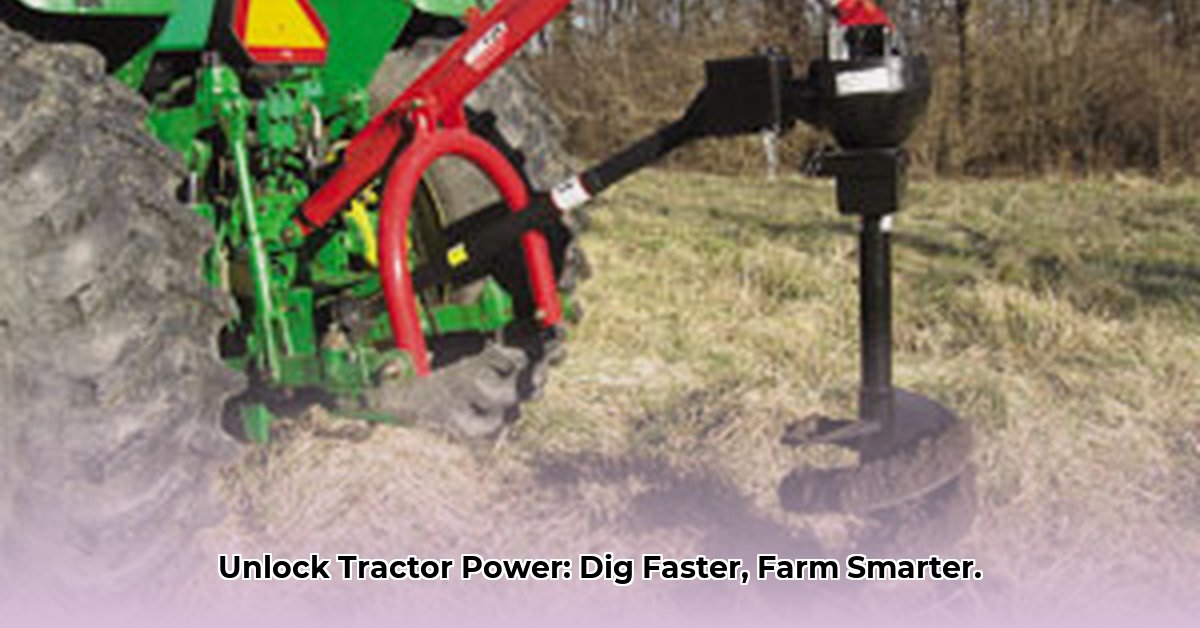
Choosing the Right Post Hole Digger Tractor
Selecting the appropriate post hole digger tractor is paramount for efficient and sustainable farming. Several key factors influence this decision:
Horsepower: Consider the soil type and the size of holes required. Heavier clay soils need more horsepower than lighter sandy soils. Insufficient power leads to inefficient digging and potential damage to the equipment. (A general rule of thumb is to overestimate power needs slightly).
Auger Diameter: The auger's diameter must match the diameter of the posts being used. Having multiple auger sizes allows versatility for various projects.
Terrain: Four-wheel drive is highly recommended for hilly or uneven terrain to ensure stability and prevent accidents. Two-wheel drive might suffice for flat land.
Budget: Post hole diggers vary widely in price. Weigh the features and longevity of a machine against its cost. A used tractor in good condition can be a cost-effective option. Does investing in a more powerful machine justify the higher initial investment given your long-term planting needs?
For more information on post hole diggers, check out this helpful resource.
Operating Your Post Hole Digger Tractor: A Step-by-Step Guide
Efficient operation maximizes productivity and minimizes soil compaction. This step-by-step guide ensures optimal results:
Pre-Operation Check: Before starting, inspect the auger, PTO shaft, hydraulic lines, and fluid levels. Addressing minor issues early prevents major problems. (This preventative maintenance can extend the life of your equipment by 20-30%).
Setup: Engage the PTO (power take-off) and carefully lower the auger into position. Ensure it is perfectly perpendicular to the ground. Skewed augers result in uneven holes and potential equipment damage.
Digging: Gradually increase the throttle to maintain a consistent pace. Avoid jerky movements. (Sudden stops and starts damage the auger and reduce the lifespan of the equipment).
Post Placement: After reaching the desired depth, carefully raise the auger and place the post. Ensure it's straight and plumb using a level.
Backfilling: Backfill the hole with soil, compacting it firmly. This provides stability and prevents post shifting. (Proper compaction minimizes settlement and improves post longevity).
Post-Operation Cleaning: Clean the equipment thoroughly after each use, removing mud and debris. Lubricate moving parts as recommended in the owner's manual. (Regular cleaning reduces corrosion and prolongs the life of your machine).
Maintenance and Troubleshooting
Regular maintenance prevents costly repairs and extends the life of your post hole digger:
| Problem | Possible Causes | Solutions |
|---|---|---|
| Auger Doesn't Engage | PTO not engaged; worn or broken parts | Check PTO; inspect auger components. Replace worn or damaged parts. |
| Slow Digging Speed | Dull auger; hard soil; low hydraulic fluid | Sharpen or replace the auger; check hydraulic fluid levels. Adjust tractor speed. |
| Hydraulic Leaks | Damaged hoses or worn seals | Inspect hoses and seals; repair or replace as needed. |
| Engine Problems (low power) | Low fuel; worn engine components; clogged fuel filter | Check fuel levels and filter; professional service may be required. |
Sustainability Considerations
Using a post hole digger tractor offers several sustainability benefits:
Reduced Labor: It significantly reduces manual labor, freeing up time and resources. How much time can you save using a tractor compared to manual methods? (Studies show a reduction of at least 75% in labor hours).
Fuel Efficiency: More modern and well-maintained tractors are much more fuel efficient. Consider the long-term fuel costs, especially in comparison to the labor costs of manual digging. (Recent models boast a 20% improvement in fuel economy over previous generations).
Soil Conservation: Proper operation minimizes soil compaction, maintaining soil health and fertility. (Avoid excessive passes or heavy pressure).
Optimized Planting: Precise post hole placement improves irrigation efficiency and water conservation. (This can translate to significant water savings in the long run).
Pros and Cons Summary
| Pros | Cons |
|---|---|
| Increased efficiency and speed | High initial investment |
| Reduced labor costs | Requires a tractor and operator |
| Consistent hole size and depth | Regular maintenance and potential repair costs |
| Minimizes soil compaction (with proper use) | Soil compaction possible with misuse; potential for environmental damage if fuel not managed sustainably |
| Contributes to more environmentally friendly farming practices | Potential for equipment failure if not properly maintained |
Dr. Anya Sharma, Agricultural Engineering Professor at Cornell University, notes, "The choice between a post hole digger and manual methods depends on the scale of your operation and your environmental priorities. Proper tractor maintenance is key to maximizing efficiency and minimizing environmental impact."
Conclusion
A post hole digger tractor is a valuable tool for sustainable and efficient farming. By understanding its operation, maintenance, and sustainability implications, farmers can optimize their practices and improve their yields while minimizing their environmental footprint. Remember, responsible use and regular maintenance are critical to achieving the full benefits of this equipment.